|
Published on Archi.ru (https://archi.ru) |
|
| 10.02.2023 | |
|
The Fluffy Space |
|
|
Alyona Kuznetsova |
|
| Architect: | |
| Andrey Asadov | |
| Alexander Asadov | |
| Studio: | |
| ASADOV architects | |
|
Designing the passenger terminal of the Orenburg airport, ASADOV architects continue to explore the space theme that they first introduced in Saratov and Kemerovo airports. At the same time, the architects again combine the global and the local, reflecting topics inspired by the local conceptual context. In this case, the building is “covered” by an Orenburg downy shawl – an analogy that is recognizable enough, yet not literal; some will see the reference and some won’t. Last year, the Orenburg airport was bought by a company jointly created by two major players at the Russian airport construction market: AO Aeroporty Regionov (“Regional Airports”) and Novaport Holding. One of the conditions was to develop three options for reconstructing the old terminal and agree the winner’s project with the regional government. The airport is situated amidst steppes, about twenty kilometers away from Orenburg, and about a hundred kilometers away from the Kazakhstan border, and the clients justly think that it may become a transfer hub on the way to Moscow and St. Petersburg from Central Asia. The building was constructed in the 1970s. The Yuri Gagarin airport in OrenburgCopyright: © KOSMOSThe Yuri Gagarin Gagarin in Orenburg. The first stage of constructionCopyright: © ASADOV architectsAndrey Asadov is quite alright with the competition that allowed his rivals to win, being only wary about possible problems during the project’s implementation.  Andrey Asadov, the leader I must give credit to the courage of the Orenburg architects, who chose the project of our colleagues by a majority of votes, and the commitment of the authors themselves to the traditions of the avant-garde. I like both our project and the project developed KOSMOS architects. Let’s hope that it will be possible to implement it as it was intended – building such an openwork cantilevered structure with such a large overhang will take a lot of work and the skills of design engineers. I am intrigued; it will be interesting to see the end result, so we wish our colleagues a beautiful implementation. We will note here that both teams used in their work one and the same image – the Orenburg downy shawl – yet they did it in different ways. The downy shawl is clearly one of the most obvious, and, more importantly, best-recognizable symbols of Orenburg in Russia. It even surpasses many other symbols connected with the city and its region: gas, oil, and salt, which are mined here, the history of Pugachev’s uprising, and the idea of reviving the population of the Przhevalsky horses, which is successfully implemented here. But no – it is only the downy shawl that sticks in your memory. On the other hand, in 2011, the airport was named after Yuri Gagarin: the first man in space studied here in the aviation school and met his future wife here. Curiously, the Saratov airport, built in 2013-2019 in accordance with the project by ASADOV Architects, was also named after Gagarin, but the name of the first cosmonaut was bestowed on it later on, in 2018, during the design and construction process. Nevertheless, it turned out that the architects worked with a “Gagarin” airport for a second time already. There was yet another experience of exploring the space theme in airport design – the terminal of the Leonov airport in Kemerovo, completed in 2020. In a word, designing the Orenburg airport, ASADOV Architects decided to explore the two key themes and placed their bets on contrast, directly combining seemingly opposite things: Gagarin and the downy shawl. 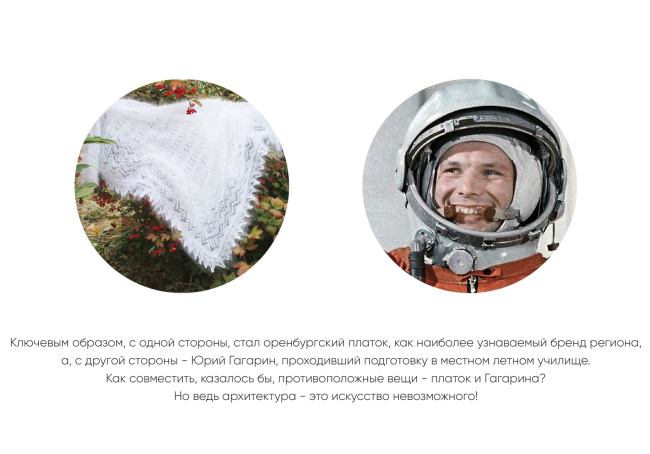 In reality, they did not combine them 100% directly. Gagarin wrapped in a downy shawl is rather the architects’ bravado. The architects opposed the nearly weightless downy shawl as something light and warm to the open space as something endless, dark, and bristling with cold stars. It looks as if they “cut out” a fragment of the Universe and wrapped it in a warm Orenburg shawl, yet raised one of the shawl’s corners, letting us take a sneak peak at the stars glittering inside the terminal. 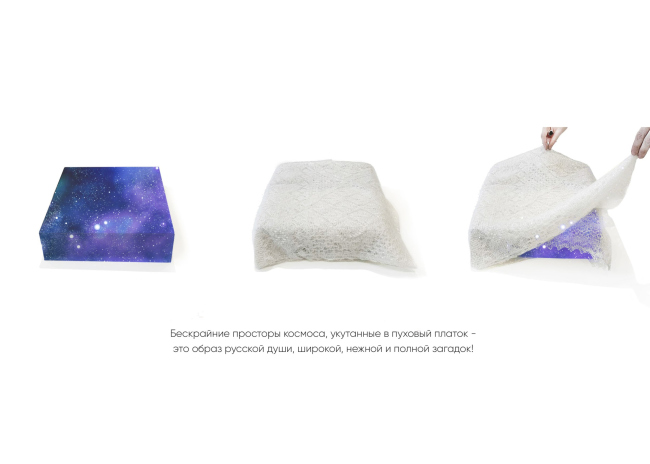 Here is what the architects say: How do you combine a downy shawl and Gagarin? Easy! On the outside, there is a warm and cozy image of a Russian soul. Then we raise one of the corners of the shawl just a little, and see the dark abyss, very much like the cosmic depths. Here you have both countermove and paradox. However, you cannot say that the opposition of the two worlds is pushed to the limit: looking at the shawl pattern, you can see icy crystals of “solar signs” – just any folk ornament, it has the idea of the universe encoded in it, while the little sparks of the “stars” in the dark-blue space reflect the modern notion about the endlessness of the universe. This is how the rhyme of “two cosmoses” appears, one of them being the one that Gagarin saw during his orbital flight, the other being the code of an ancient culture that survived into the present in the well-known decor (I think it will be appropriate to mention the fact that in the Ancient Greek the word “cosmos” stood for everything that was orderly, decorated, or beautiful). Thus, the architects combined two notions of cosmos or space – the ancient and the modern ones. We will note that at the first city conference ASADOV Architects showed two versions. In one of them, the shawl theme was explored more vividly: there was a ring standing in front of the façade – a ring, through which, as is known, a really good shawl is supposed to be able to pass.  The first version of the concept. The Yuri Gagarin airport in OrenburgCopyright: © ASADOV architectsThe city council of Orenburg opted for the second version – and the architects themselves like it better: the simple glass volume of the terminal is covered by an ornamental “shawl”; one of its edges arches slightly, resembling not just a curve of a fabric but also the trajectory of a plane taking off – and then the “down” of the shawl can be interpreted as a vapor trail. The Yuri Gagarin Gagarin in Orenburg. The first stage of constructionCopyright: © ASADOV architectsThe project by ASADOV Architects provided for three stages of the airport development. During the first stage, the new terminal would be built next to the old one which would make it possible for the airport to continue operating. The Yuri Gagarin Gagarin in Orenburg. The first stage of constructionCopyright: © ASADOV architectsThe second stage included dismantling of the old terminal and creating a park area in its place – it could be useful not only for the passengers and those who came to meet them or see them off, but also for the visitors of the nearby civil aviation, as well as the guests at the airport hotel. The Yuri Gagarin Gagarin in Orenburg. The second stage of constructionCopyright: © ASADOV architectsShould the airport become overloaded and should a necessity arise to expand it, the third stage is engaged: a second terminal is constructed, which mirrors the first one. The concept is preserved, only instead of the corner of the “shawl”, a symmetrical canopy appears on the main facade. 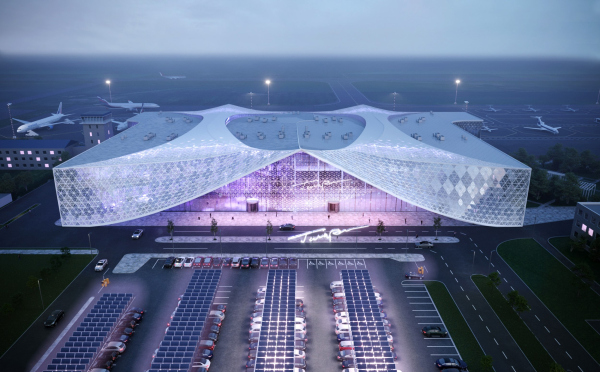 The Yuri Gagarin Gagarin in Orenburg. The third stage of constructionCopyright: © ASADOV architects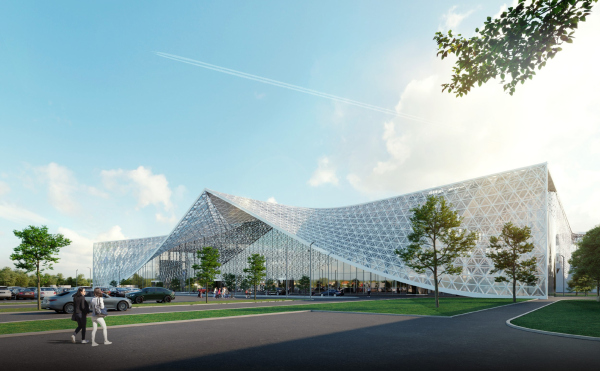 The Yuri Gagarin airport in Orenburg. The third stage of constructionCopyright: © ASADOV architects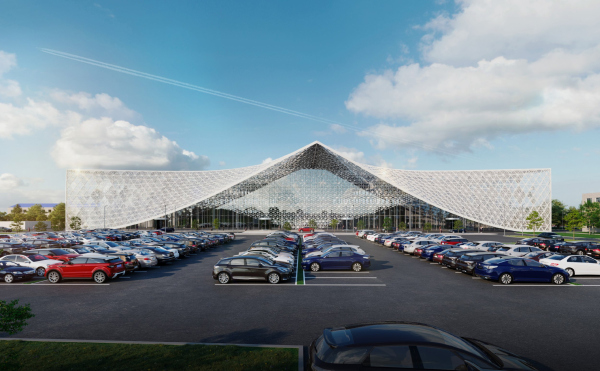 The Yuri Gagarin airport in Orenburg. The third stage of constructionCopyright: © ASADOV architects The Yuri Gagarin airport in Orenburg. The first stage of constructionCopyright: © ASADOV architects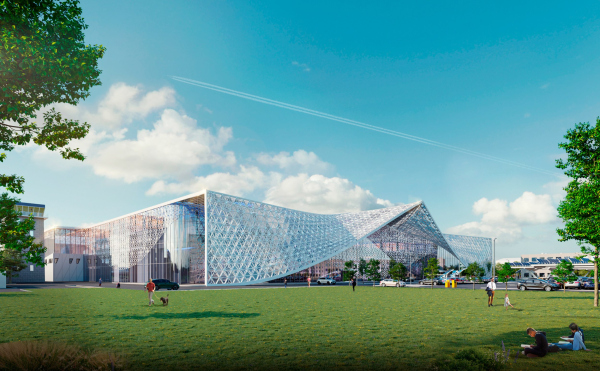 The Yuri Gagarin airport in Orenburg. The second stage of constructionCopyright: © ASADOV architects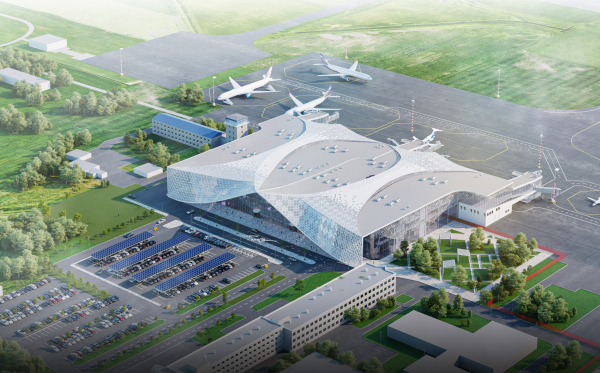 The Yuri Gagarin airport in Orenburg. The third stage of constructionCopyright: © ASADOV architectsHowever, even if the second part will never appear, the statement remains clear, and the image remains bright. The terminal is essentially a multilayered “crystal” volume. Its first layer is a transparent parallelepiped, consisting almost solely of stained glass constructions. A part of it is covered by a weightless “cobweb” of a decorative grille, streaming down in waves. Above it, there is a denser, yet still openwork, volumetric structure: let’s imagine that the shawl was folded in two, and then in two again, and the pattern became less prominent, but still discernible. The elevated corner of the upper layer forms a marquee with a more corporeal rigid structure, yet still transparent. Its volumetric construction spills over to the roof and the facade from the side of the airfield, “stretching up”. 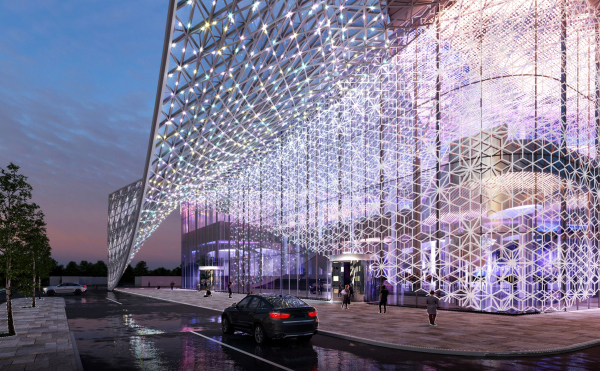 The Yuri Gagarin Gagarin in OrenburgCopyright: © ASADOV architects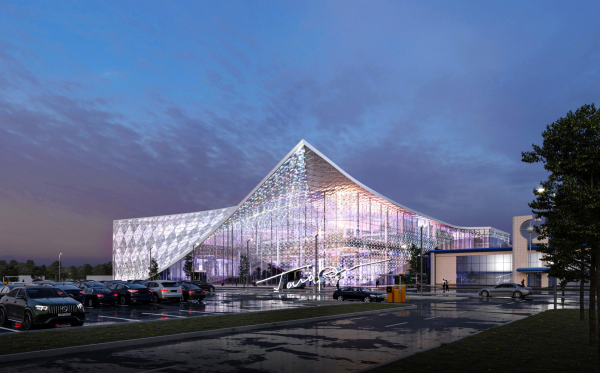 The Yuri Gagarin airport in Orenburg. The second stage of constructionCopyright: © ASADOV architects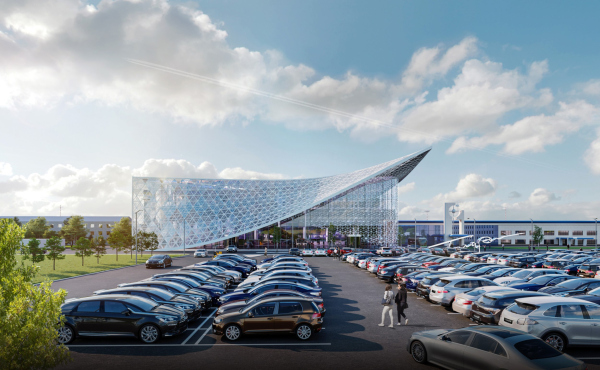 The Yuri Gagarin airport in Orenburg. The first stage of constructionCopyright: © ASADOV architects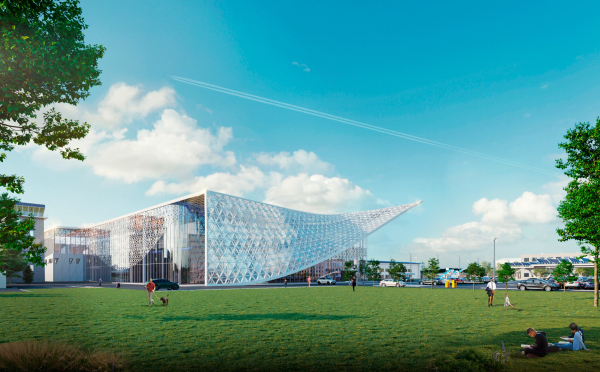 The Yuri Gagarin airport in Orenburg. The second stage of constructionCopyright: © ASADOV architectsIn the nighttime, a “star scatter” appears underneath this corner: spotlights of various colors are installed in the nodes of openwork structures, which are reflected in the stained glass windows, being superimposed on the cobweb of the decorative grille. All of this not just effectively creates an effect of a “sky full of stars” – differently colored lights and openwork grilles create a festive mood, a feeling of anticipating the flight and changing your circumstances. In the interior, the duality of the dark glittering cosmic space and the fluffy handmade shawl is felt even stronger. The white openwork structures meet the dark perforated ceiling that has pinpoint lights and large circular “crater” lights installed in it. The gray glittering metallic tones contrast with the trees and spots of lights, slightly blurred, like aurora borealis: these come from glass barriers, neon backlighting and video projections. 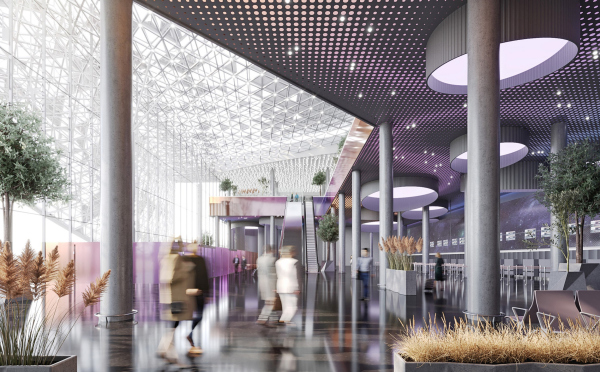 The Yuri Gagarin Gagarin in OrenburgCopyright: © ASADOV architects The Yuri Gagarin airport in OrenburgCopyright: © ASADOV architects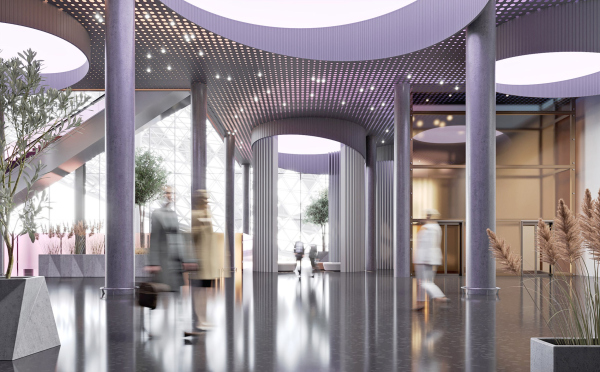 The Yuri Gagarin airport in OrenburgCopyright: © ASADOV architects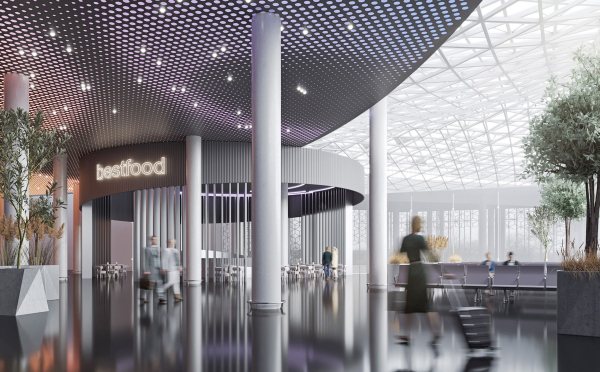 The Yuri Gagarin airport in OrenburgCopyright: © ASADOV architectsAnd, finally, we will note that the image of outer space and even the contrast between the downy shawl and space are rather given as hints. Nothing is what it seems. We can speak about the image of the shawl, but it is by no means garish, and the openwork canopy looks rather like some fashionable architectural technique than a direct quotation; the same refers to the spotlight stars from the smart backlighting system. The architects’ tremendous experience with working with airports and the topic of space does bring its results. |
|




